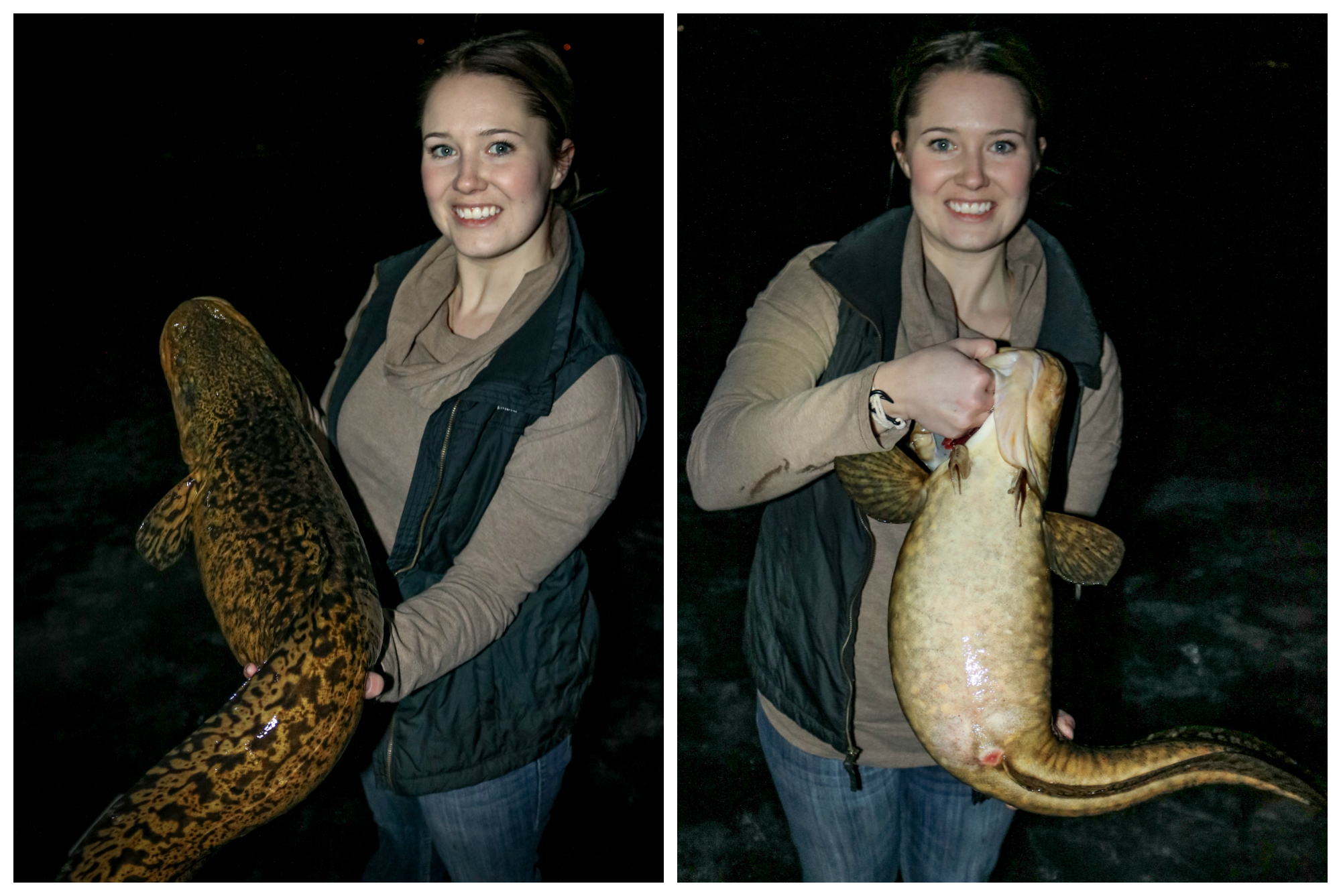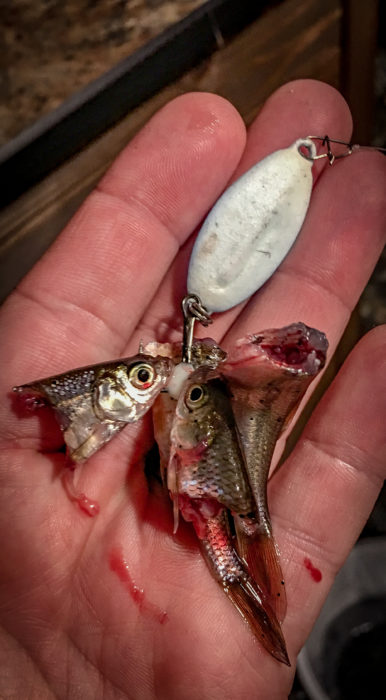The early ice fishing formula for
success with
"Tackle" Terry Tuma
by Terry Tuma
With the arrival of hard water, “Tackle” Terry Tuma answers some questions for fishing multiple species through holes in the lakes the next several months. Catch a live seminar with “T3” next weekend at the St. Paul Ice Fishing and Winter Sports Show at RiverCentre.
Q: Will jigging spoons catch winter crappies and sunfish?
“Tackle” Terry: Most winter panfish anglers will avoid spoons because they consider them strictly walleye lures. They shouldn’t!
Size, color, vibration and action is key to catching aggressive and lockjaw pans. Work more aggressive presentations for periods of high panfish activity levels. I do this by intensifying lift-drops coupled with short pauses and holds with my Rapala jigging spoons. Slow down the movement for those tough biters with fewer, shorter lift-drops and increase hold times.
Lures in sizes of 1/12 and 1/16 ounces are both attractors and triggers. Tease the slabs by adding one waxworm on each tine, or a minnow on one tine hooked parallel to the dorsal fin. Drill two holes 2 to 3 feet apart for both stubborn crappies or sunfish and rapidly pound bottom in one hole which becomes an attractor. Trigger with a dead stick, bobber system or small, slower presentation in the other opening. This is a one-two approach that will produce winter walleyes, too!
Q: When should I set the hook with jigs for ice walleyes?
“Tackle” Terry: On all water bodies, a heavy thump indicates a walleye has inhaled your bait, so set the hook quickly. If you feel ticks, fish are just nipping baits, so hold off. Gently and slowly lift the jig up an inch to force the walleye to bite up. Another approach is to drop the rod tip down to create semi-slack line and let the fish chew the minnow for a few seconds. Stinger hooks are a last resort, though I try to avoid them. Finally, be sure your hook gap is wide and hooks are sharp!
Q: How do you hook minnows under bobbers for ice crappies? And what about size?!
“Tackle” Terry: Place your hook parallel to the dorsal fin point-forward for a natural look. Hook it near the tail to imitate an injured baitfish for reluctant biters. Pin minnows (1-inch long or less) usually are my best producers. That said, always keep crappie minnows, small fatheads, and shiners in the bait bucket.
As for size, that really depends on mood, water clarity, light levels, and “matching the hatch.” Always replace the bait after you catch a crappie. Likewise, use a new minnow after 8 to 10 minutes to refresh scent and movement.
Q: Where should I cut off minnow heads and how often should I change them in ice fishing scenarios?
“Tackle” Terry: You’ll see an excellent increase in scent and taste by changing heads every five to 10 minutes, especially for non-aggressive walleyes. This may determine whether a fish bites or not. Always pinch off the head between the dorsal fin and gill plate instead of cutting. That added “meat” and jagged skin edge boosts the scent, flash and movement factor, which intensifies the strike response!
Q: How do you adjust when marking ice sunfish on electronics but you can’t get them to bite?
“Tackle” Terry: Raise or lower your lure to the fish in water column, then try subtle jigging, hold, or draw it up 2 to 3 inches above band to coax bites. Do not waste more than 30 seconds working these fish. Target different ones.
If this reoccurs, change lure size, drop speed, color, or design. Experiment with one, two, or three spikes and waxworm size, too. These fish are curiosity seekers and not active eaters. Fish usually are negative to neutral if change-ups produce, assuming you started with legitimate bait and lure selections.
BE VERSATILE FOR MORE ICE-FISHING SUCCESS
by Bob Jensen
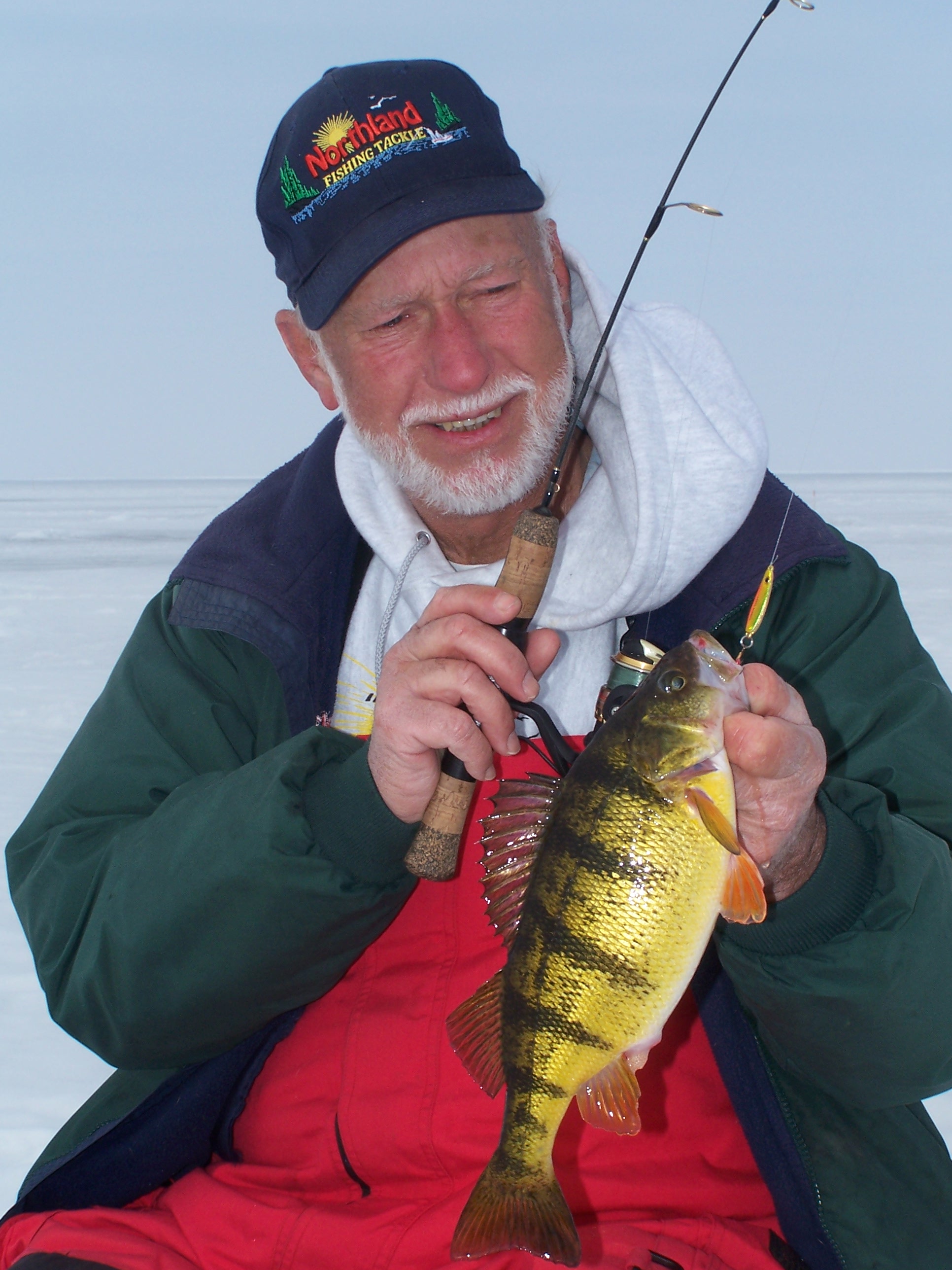
Across the ice-belt there are several species of fish that anglers have the opportunity to catch from under the ice. Walleyes, northern pike, perch, crappies and other types of panfish, smallmouth and largemouth bass and even catfish can be caught by ice-anglers. The thing is, our presentation needs to change for the different types of fish. Different species of fish respond to different presentations. Walleyes like spoons, panfish like tiny jigs, and pike like natural baits. If you’re targeting a particular specie of fish, you need to employ a technique that that specie is most likely to respond to.
However, there are some basic principles of fishing that you need to keep in mind regardless of what fish you want to catch. Following are some of those basic principles.
The most important consideration is finding the areas where the fish are most likely to bite your bait. Some community holes will hold lots of fish, but fishing pressure makes those fish very selective. And, after awhile, those community holes get fished down. Take some time to search out other areas away from the fishing pressure: Those fish will be more likely to bite your bait, making them easier to catch.
Once you find the fish, you want to keep your bait above them for a couple of reasons. First of all, fish see up better than they see down. If your bait is above them, they’re more likely to see it, which makes them more likely to eat it.
The other reason for keeping your bait above the fish is to possibly prevent spooking the other fish around them. If you see fish on the sonar, drop your bait but stop it when it’s still three or four feet above the fish. Active fish will come up and take the bait. Catch the active ones first. If they quit rising to the bait, then allow it to get closer to them. If you drop it into the group of fish right away and catch a couple, the rest of the school might spook. Make the active ones move away from the school to prevent spooking. I use a Vexilar FLX-28 in the Zoom Mode much of the time. This unit enables me to “zoom” in on a particular zone, so the definition is really good, and I’m able to position my bait exactly where I want it to be.
Another important thing to keep in mind for more ice-fishing success for any specie: If they’re not responding to what you’re doing, do something else. If you chase panfish when you’re ice-fishing, you probably know how productive some of the different baits in the Bro’s Bug Collection can be. These are baits that were designed for ice-fishing. They’re all very small, and each has its own distinctive quality. The differences may not be that much, but the fish can tell the difference and at times will favor one over the other.
Last thing: As the ice-fishing season proceeds, don’t sit on one hole too long. I know lots of ice-anglers that move constantly. If they’re on a big structure, they’ll put an auger, sonar, and anything else they need into a portable shelter and just keep popping holes until they find the fish. The Otter Pro Cottage is perfect for this plan of attack. It can seat two anglers, but I like plenty of room, so I use this unit even when fishing alone.
Now is when you need to be ice-fishing. If you employ the tactics above, you’ll catch more fish more often when you go ice-fishing.
PHOTO CAPTION—Mr. Walleye Gary Roach with a jumbo perch. Gary is one of the pioneers in the fishing industry who taught us how to catch more fish through the ice.
To see new and old episodes of Fishing the Midwest television, fishing articles, and fishing video tips, visit fishingthemidwest.com
The 20 Best Ice-Fishing Lures
By Mark Modoski
Every ice angler has a go-to lure they swear will out-fish anything. Whether you’re ice-fishing for panfish, walleye, bass, or trout, you have plenty of great baits to choose from. But with so many jigs, spoons, soft-plastics, and lipless crankbaits out there, it’s no easy task deciding which lures will catch the most fish. In order to pick the best ice-fishing lures available, we consulted two of the top ice guys around. Hard-water experts Craig Oyler and Ross Robertson ran down their favorites. And with added input from other local sharpies, we narrowed down the list—in no particular order—to the 20 best ice-fishing lures. Better make some extra room in your tackle boxes.
Salmo Chubby Darter
The Chubby Darter is an ice-fishing legend, and you won’t find a more effective vertical lure. Its slow sink rate and unique shape imparts a tantalizing swimming action that draws strikes. It has become a mainstay among ice anglers, and is equally effective for catching walleye, perch, bass, crappie, and pike. The Chubby Darter is available in 1 3/8- and 1 ¾-inch models in six detailed, lifelike patterns.
CLAM Leech Flutter Spoon
The highly reflective finishes of the Leech Flutter Spoon flicker light to give the image of fish scales. Coupled with a distinctive flutter that tumbles back-and-forth on the drop, the lure is a master at triggering fish with its irritating and enticing flare. The Leech Flutter Spoon is made from a zinc alloy that is lighter than metals used in other spoons, and the lightweight design slows the sink rate, keeping the Leech Flutter Spoon in the striker zone longer.
Why female walleye (and other gamefish) grow so much bigger than the males
Big females are champion spawners, but the males matter, too
By Gord Pyzer
Buddy Jeff Matity sent me a photo the other day of his brother Jason with a gorgeous 29-inch walleye, that he caught last week while ice fishing on Last Mountain Lake, Saskatchewan. What made the catch even more remarkable, however, was the fact that the giant walleye was a male.
With very few exceptions—northern range smallmouth bass being one of them—the advantage in the fish world almost always goes to the female members of the population, which grow much bigger in order to produce more eggs. That’s the reason why it is very rare, for example, to catch a male muskie that is bigger than 40-inches.
But, what you might find even more fascinating is how Matity (who heads up Saskatchewan’s Fort Qu’Appelle Fish Hatchery) and other biologists distinguish male fish from female fish by simply looking at them.
“I gave this tremendous character of a fish the name Donkey Kong,” says Matity, “because of its enormous head, slender body; large, thick, gnarly fins and grey-ghost appearance. I am familiar with what big male walleye look like from doing spawn camp on this system, and these qualities are tell-tale signs of a very old male. Indeed, we have several (although exceedingly rare) brood stock males in the 25- to 27-inch range that are still good spawners with good volumes of sperm and no discernible lack of quality.
“At any rate, Jason’s big walleye is an exceptional trophy, not only because of its weight, but because it is a unicorn of a fish—an ultra-rare gigantic male.”
Matity went on to say that when he is handling captive rainbow, brown and brook trout of both sexes in the hatchery, as well as wild stocks of lake trout and walleye, he sees common physical characteristics developed by fish near the end of their lives.
“When compared with much younger female fish of comparable length,” says Matity, “male trout, walleye, northern pike and yellow perch have heads that are disproportionately larger and longer. Their eyes are often clouded over with cataracts, their pigmentation changes from gold to grey, there is a thickening or “stubbiness” to their fins and roundness to the caudal fin (sloughing off most or all of the yearly growth of fin edges) and a leanness to their bodies.”
Matity also mentioned that when he and his team have collected lake trout spawn in northern Saskatchewan, they have taken fin ray samples of similar looking 6- to 8-pound trout. The male fish had the characteristic “thick fin” phenomenon and were aged at 26 years old. The same size females, on the other hand, were only nine years old.
“These lake trout demonstrate what often happens with trout,” explains Matity. “The males seem to nearly ‘stunt’ at a smaller age, while the females grow considerably larger. That’s because increased body size means increased egg mass and volume for increased reproduction.
“Mother Nature does not urge males to grow as big, since sperm are infinitely tiny compared to eggs. As long as an individual male is healthy, he can produce fresh, viable sperm for the entire spawning season, unlike the one-shot quantity of ripe eggs from a female.”
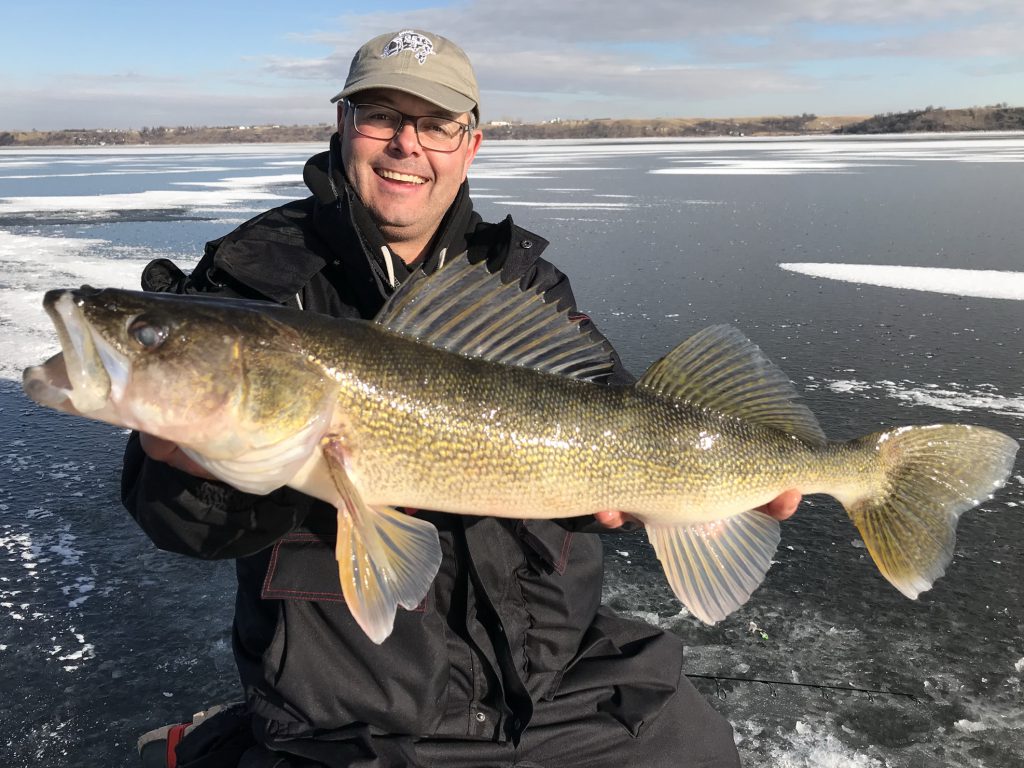
Given all this, then, why did Jason Matity’s male walleye grow so big?
“The literature suggests that a male walleye over 25-inches is virtually non-existent,” says Matity. “So why did Last Mountain Lake produce this guy approaching 30-inches? Superior genetics definitely played a role. But I believe food, and the way Mother Nature rationed it out, created “the perfect storm” for Donkey Kong.
“The first five or six years of a walleye’s life are the most significant for skeletal body growth. This fish likely was the product of the resurgence of yellow perch and other forage fish around the time of the 2008 and 2011 floods on Last Mountain Lake. Those floods raised the water level, dropped the salinity, and kicked out record year-classes of many fish species.
“Beyond age six, I believe this fish was able to seamlessly bridge the gap between eating perch and shiners, to eating juvenile and adult ciscoes, and continue what were virtually, back-to-back floods, and steam train-like growth spurts.
“It is evident, however, by its faded colour, thickening and rounding of the fins; long, lean, uninjured body; cloudiness of the eye (that’s not ice in the photo) and gator-like head, that this fish has had arrested or significantly slowed growth for many years, giving it the ‘classic male’ look.”
Of final interest, and surprising to many, I am sure, Matity says that the vibrancy of these rare old male walleyes is still excellent, just as it with the giant female fish he often has the luxury of handling.
“The most impressive walleye I ever handled was a female fish from Diefenbaker Lake that weighed 17 pounds, and produced over 500,000 eggs. Along with the other gigantic fish from which we collected eggs, the combine fecundity exceeded 80 per cent. That’s why big fish matter—even males.”
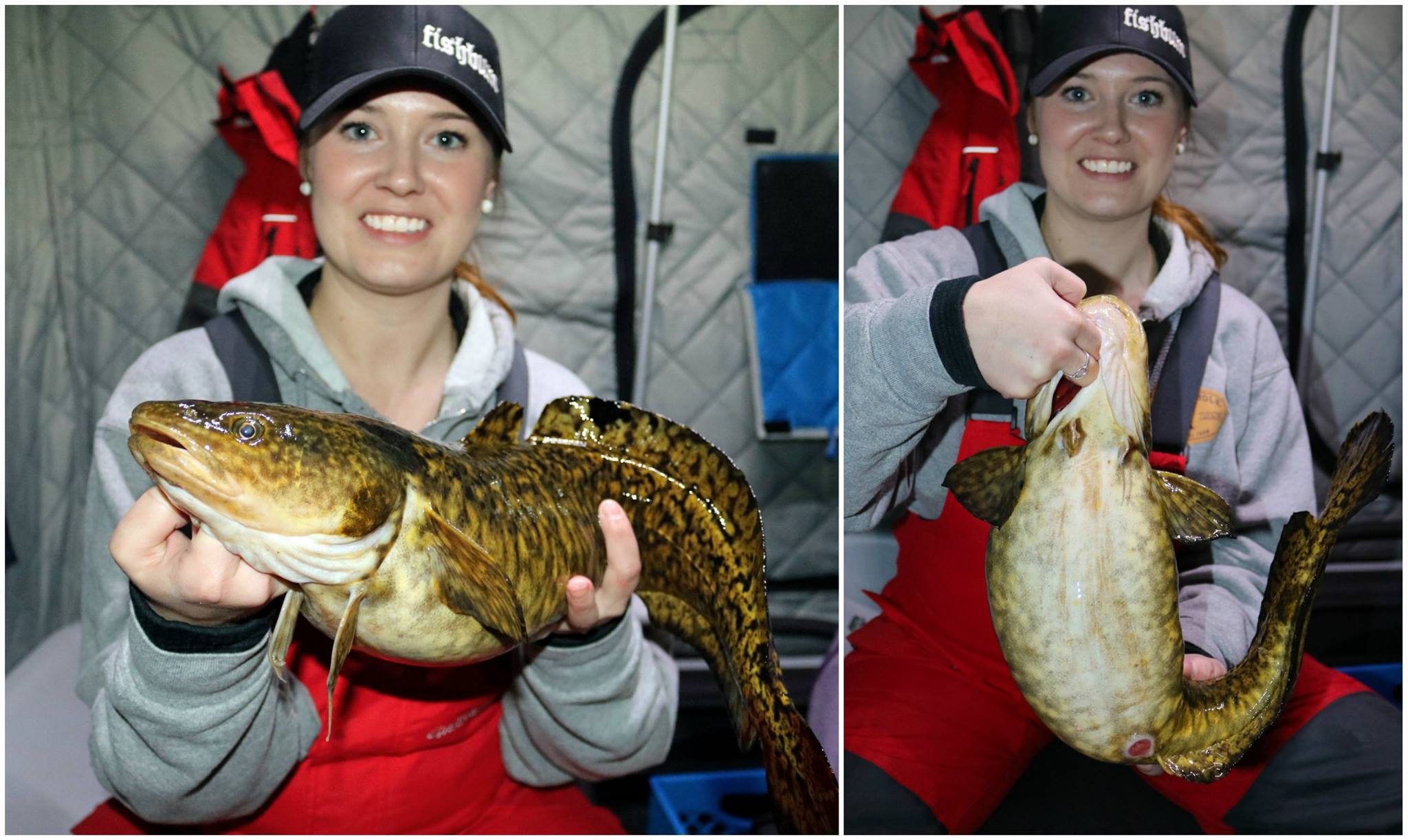
Ferocious, aggressive and awkwardly flexible, burbot are remarkable predators that have become one of my favorite species to target through the ice. The fight was what first got me hooked on this misunderstood water dragon — hook into just a schmedium-sized ‘pout and you’d swear you were pulling up a 27”+ walleye. The combination of their hefty guts and the rockstar-esque head banging is sure to slap a smile on even the burliest of beards.
For the love of burbot
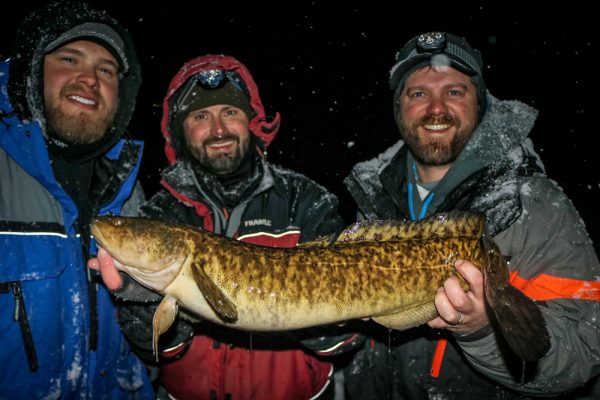
With a single whisker under its chin — just like I had up until my mid-twenties — I can’t see myself connecting with any other species of fish on a more personal level. I mean look how they rock that big belly with pride! If I could share bunk beds with one, I would — swapping stories until we fell asleep, both dreaming of that next bacon cheeseburger…. Even our sleep schedules would line up as they’re the night owls of the fish community.
Never eat right before going to bed? Burbot ignore the advice from all of those fancy nutrition magazines, regularly opting for the late-night snack run instead. While you can catch the occasional ‘pout during the day, the prime bite occurs after dark and well into the night.
Where to find ‘em
Note: The type of structure may be a little different for some of our Canadian neighbors waaaay up yonder, but how/what we catch ’em on is much the same.
Hard, gravel-bottomed humps are king in late February and March when burbot spawn on bigger bodies of water. But don’t overlook deep weed edges at the bottom of steep breaklines — preferably off the edge of a large feeding flat. Burbot follow the food just like other predators.
Some of the best bites I’ve ever been on have been a mile away from any rocks, and those belly draggers would even come up the hole with mud stuck to their guts to prove it. These fish are there because the area offers a great late-night menu, and burbot aren’t afraid to hit up the drive-through more than once.
During daylight hours: Cruise the basin looking for water in the 40-60’ range near the deepest holes in the lake. These deep-water haunts may hold fish, but consider any fish caught during the daytime to be a bonus. The good news is that pinpointing these areas makes it easier to predict and follow their evening migration.
As the evening progresses: Slide up towards the base of the dropoff where the basin meets the bottom of the break. These areas will look like classic walleye structure, which is why you hear of so many ‘eye guys complaining about accidentally catching burbs. This breakline bite is usually best for the 1-2 hours past sunset.
After dark: Gradually work your way into shallower water until you’re fishing on top of the hump/flat that levels off in 10-20’. Focus on fishing the very edge of the top of the flat before it breaks off into deeper water.
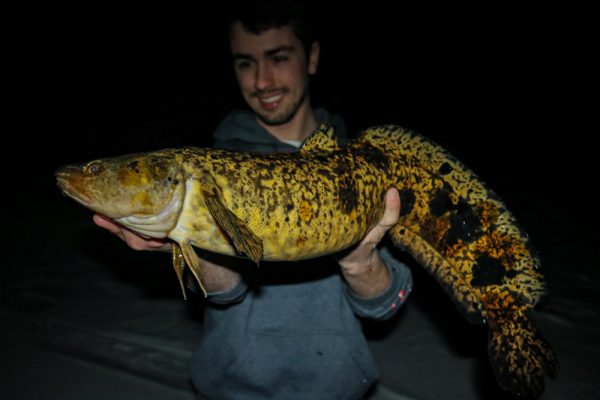
What to catch ‘em on
My go-to jigging spoon is called the Trout-N-Pout Spoon by Big Nasty Tackle, which are specifically designed for eelpout (yup, for real!). Years of banging them on the bottom and I still haven’t chipped the paint. They’ve got a super compact profile compared to their weight, which provides the perfect balance of bottom-pounding ability with the necessary flutter/wobble for enticing the picky biters.
The majority of the time I prefer using the 5/8-oz size, but don’t be afraid to bump it up to 1-1/8 oz when fishing in deeper water…say 40ish feet or better. May sound ridiculously heavy, but that extra oomph allows you to pound the lake bottom to stir things up and call those nosy burbots in from a distance.
The brighter the better when it comes to burbot, and the Trout-N-Pout Spoons have the brightest, longest-lasting glow that I’ve found. Green glow is a tough color to beat. Still, I’ll reel up and re-glow my bait about every 10-15 minutes. Local ‘pout expert Jason Rylander put it best: “I have been playing with larger profile baits and having real nice success. Again glow is key, but these fish are not afraid to go after a big offering”.
These particular spoons also have built in rattles for added attraction. Tip ‘em with a matching pair of torn-in-half shiners or fatheads, and you’re in business — the business of burbot — which is an outstanding business to be in. Don’t be stingy on the minnows either. Pile ’em on and replace ’em often to make sure you’re getting as much scent into the water as possible.
There’s nothing wrong with the stock hooks on these spoons, but sometimes I’ll play around with swapping ’em out for a dressed- or glow-treble hook. The VMC Glow Resin Trebles have got a glow-in-the-dark infused epoxy resin that screams, “Bite me!” when it’s swinging back and forth in the water. They’re sticky sharp and stout enough to handle an angry burb throwing around its weight. But it’s that extra glow shining from the middle of the shiner heads that I feel gets me a few extra bites over the guy next to me.
Getting ’em to bite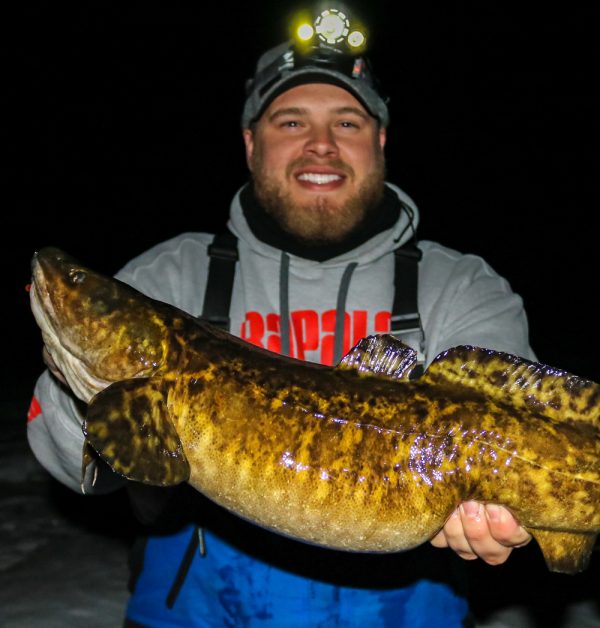
Burbot primarily feed tight to bottom. Skip the “5-second rule,” they don’t mind picking their dinner right up off the lake floor. I like to pound bottom several times to stir things up, then lift my spoon 6-12” off bottom and dance it in place for several seconds. This makes the glob of shiners do a tantalizing dance as they disperse scent and vibration into the water. Then I’ll do a larger lift of the rod tip at the end of the dance and let the bait crash back down into bottom before starting over.
You won’t always graph ‘em, often times your rod will load up as you go to lift your presentation off bottom. Still, you need to make sure to keep a close eye on your flasher. Some of your bigger bites could come through as a large, active blob 3-6′ off bottom, and would pounce on a glob of shiners raised up and placed in front of their face.
Respect the ‘pout
It used to be very common to see the random burbot lying slaughtered on the ice, frozen and wasted. This is an illegal act, one of which is very ignorant and frowned upon with any species, and eelpout are no different. Never leave a man behind.
They provide exceptional table fare! Boiled or deep fried, burbot are known as the “poor man’s lobster” for a reason. If you’re not going to take the time to clean what you catch, let it go for another person to enjoy the epic battle that ‘pout offer. I realize there is no limit on burbot, but let’s practice selective harvest. Keep the smaller males if possible and let those big ladies swim. Approximately 20% of a big females weight is thanks to her eggs. That’s a lot of baby burbs!
Respect the ‘pout. You’re sure to gain a newfound appreciation for these leopard-printed hand bags with shoulders after hooking up with one. Sit back, enjoy the ride, and hope your drag is set accordingly.
